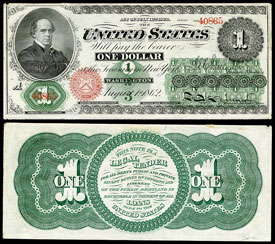(Joshua D. Glawson, Money Metals Exchange) There is an untold story in American monetary history. Some are reluctant even to discuss it.
I’m referring to the U.S. Secret Service’s very own role in the destruction of sound money in America.
As constitutional, sound money in the form of physical gold and silver coins – whether minted privately or not – became an annoying impediment to expanding the size and power of the federal government, central planners began circulating unbacked paper proxies and formed a Gestapo-like police agency to enforce the scheme.
Founded in 1865, toward the tail end of the American Civil War, the Secret Service originated as a branch of the U.S. Treasury Department.
The primary job of this federal police force was to prevent others from counterfeiting the U.S. currency, which had just been nationalized through acts of Congress via the National Currency Act of 1863 and the Coinage Act of 1864.
Together, these acts formed what are commonly known as the National Banking Acts of 1863 and 1864.
These Washington, D.C. laws imposed taxes with a levy court system and implemented direct taxation. This led to the country’s first income tax. The government also strengthened the establishment of the Internal Revenue Service (IRS), which had conveniently begun operation in 1862. Conjointly, these propped up the new federal fiat currency system.
From around 1837 through part of the Civil War, currency issuance and banking in America had been directed by a more decentralized network of states and free banking institutions. These entities issued banknotes that could be cashed in for standardized gold or silver coins or traded for goods and services.
During the Civil War, however, both sides issued their own banknotes to help fund their respective war efforts, often unbacked by the two monetary metals.
The Union pushed forth greenback fiat currency in Demand Notes and United States Notes. At the same time, the Confederates printed fiat greybacks in the forms of Confederate Dollars and Confederate Treasury Notes.

The number of fiat dollars in a bank and region in the new era would be largely based on population rather than gold and silver reserves, which is one reason the Union continued to encourage immigration both for fiat monetary support and war efforts.
The Union pushed to expand American territories through these Acts to increase population and issuance of government fiat money.
Since the Union and Congress sought to impose a federal fiat legal tender currency system that did not rely on tangible value and voluntarism, they needed enforcement of those laws. Those supporting laws included income taxes and establishing the IRS.
The war, economic strife, and competition between currencies created various types of “counterfeit” currency.
Government officials made haughty claims that one in three fractional gold or silver coins at that time were counterfeit and did not contain their original gold or silver weight. By decreasing the amount of gold or silver in a coin, a counterfeiter could turn a profit.
Yet, these government hypocrites had no qualms about mandating that unbacked fiat currency must be considered legally equal to gold and silver coinage. Nor did they object to the illicit profit this enabled the central government to rake in.
Sadly, the U.S. Supreme Court notoriously affirmed this devious scheme when deciding the “Legal Tender Cases,” considered by many legal scholars (including present-day Justices on the high court) to have been wrongly decided.
As such, the government changed the definition of money and citizens could henceforth be compelled to accept non-redeemable paper as equal to gold or silver coins.
On April 14, 1865, President Abraham Lincoln signed legislation establishing the Secret Service to combat counterfeit money – the non-government type, that is. Later that same day, Lincoln was assassinated, and he died on April 15.
From 1865 to 1901, the Secret Service’s main mission was to bust private counterfeiting operations. In 1881, President James Garfield was assassinated – interestingly, not too long after publicly advocating for a return to the gold standard.
Then, in 1901, with the assassination of President William McKinley, and under the new presidency of Theodore Roosevelt, the Secret Service was given the additional task of defending U.S. presidents. (McKinley’s assassination occurred a year after he signed the Gold Standard Act of 1900, which halted bimetallism by diminishing the monetary role of silver.)
The Secret Service grew from its original role of helping to ramrod a new fiat currency standard into a much larger police force that also protects the U.S. Presidents.
A full 50 years before the Christmas Eve passage of the Federal Reserve Act of 1913, Congress had already set in motion a plan to rob our nation’s monetary system of its gold and silver, slip a fiat currency into circulation, promote fractional reserve banking, stamp out state and private banknotes, strengthen the IRS, and spawn the Secret Service to help enforce it all.
The solution is to return to a free market for money – a system of competition where gold and silver are permitted to circulate alongside other forms of payment – and to remove government force from the equation.
May the best currency win.

